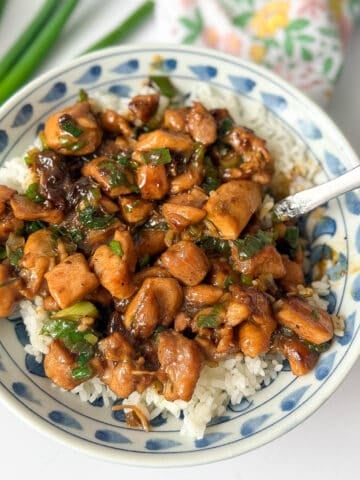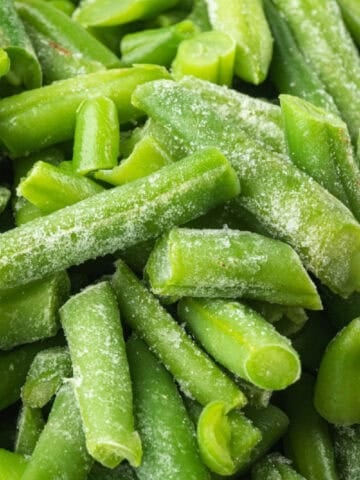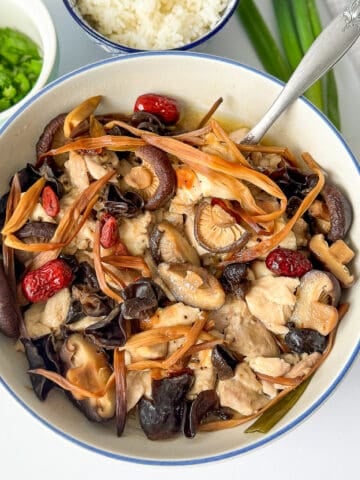Introduction
Thai food vs Chinese food? Food is an integral part of the culture wherever we go, we learn about the different cuisines that call that place home. However, when it comes to Asian cuisine, two of the most popular contenders are Thai food and Chinese food. Thai and Chinese cuisines are renowned worldwide for their rich flavors, vibrant ingredients, and diverse culinary traditions. In this post, we’ll look at the differences between Thai food and Chinese food, from ingredients to flavors to cooking styles.

Jump To
What is Thai food
Thai cuisine is celebrated for its harmonious blend of sweet, sour, spicy, and salty flavors. It draws inspiration from various Southeast Asia cultures and showcases a vast range of aromatic herbs, spices, and fresh ingredients. Thai dishes often feature a balance of contrasting flavors, creating a delightful sensory experience.
One of the defining features of Thai cuisine is the use of herbs like lemongrass, galangal, and kaffir lime leaves, which infuse dishes with their distinct fragrances. The prominent use of chili peppers and fish sauce lends a fiery and umami-rich taste to many Thai dishes. Popular Thai dishes include tom yum goong, pad Thai noodles, som tam, green curry, and mango sticky rice.
What is Chinese Food
With its long history and regional diversity, Chinese cuisine offers a vast tapestry of flavors, textures, and cooking styles. It encompasses various regional cuisines, such as Sichuan, Cantonese, Hunan, and Shanghainese, each with distinctive characteristics.
Chinese dishes often prioritize a harmonious balance of flavors, emphasizing freshness and natural tastes. Key ingredients include soy sauce, ginger, garlic, scallions, and a wide variety of vegetables, meats, and seafood. Chinese cuisine is also known for its versatility in cooking methods, such as stir-frying, steaming, braising, and deep-frying.
Some beloved Chinese dishes include Peking Duck, Dim Sum, and Mapo Tofu. Chinese cuisine's diverse flavors and textures provide a delightful exploration of tastes, from mild and subtly sweet dishes to bold and spicy flavors.
What are the differences in ingredients?
Thai food and Chinese food are incredibly diverse and rich in flavors, but they have some notable differences in ingredients. Here are a few key distinctions:
Herbs and Spices
- Thai Food: Thai cuisine is known for its vibrant and aromatic flavors, often achieved through the use of fresh herbs such as lemongrass, Thai basil, cilantro, mint leaves, and galangal. These herbs contribute to the unique fragrance and complexity of Thai dishes. Additionally, Thai dishes incorporate a variety of spices like turmeric, cumin, and coriander, which add depth of flavor.
- Chinese Food: Chinese people relies heavily on a combination of aromatic spices like ginger, garlic, cinnamon and star anise. Commonly used herbs include green onions, cilantro, and Chinese parsley. Soy sauce, oyster sauce, and five-spice powder are staple ingredients that add distinct umami and flavor to many Chinese dishes.
Sauces and seasonings
- Thai Food: Thai cuisine features a range of sauces and seasonings, including fish sauce, shrimp paste, tamarind paste, and coconut milk. Thai dishes often balance sweet, sour, salty, and spicy flavors. (spicy level varies)
- Chinese Food: Chinese cuisine offers a variety of sauces and seasonings, such as soy sauce, hoisin sauce, black bean sauce, and vinegar. Soy sauce, in particular, is widely used for seasoning in Chinese cooking, providing a savory umami flavor.
Rice and noodles
- Thai Food: Thai cuisine commonly uses fragrant jasmine rice as a staple. Rice noodles, such as thin rice vermicelli or wider flat rice noodles, are also popular in Thai dishes like Pad Thai and Pad See Ew.
- Chinese Food: Chinese cuisine encompasses various rice and noodle varieties. Steamed white rice, jasmine rice, and fried rice are commonly enjoyed. Chinese noodles come in various shapes and sizes, including egg noodles (lo mein and chow mein), rice noodles, and wheat noodles. Chinese cuisine also has a broader range of staple carbohydrates, including dumplings and steamed buns.
Protein sources
- Thai Food: Thai cuisine utilizes a variety of proteins, including seafood like shrimp and fish, chicken, pork, beef, and tofu. Thai people use the combination of proteins and vegetables to create harmonious flavors.
- Chinese Food: Chinese cuisine encompasses various protein sources, including pork, chicken, beef, seafood, and tofu. Chinese dishes often mix meats and vegetables, stir-fried or braised, to retain their flavors and textures.
Regional variations
- Thai Food: Thai cuisine is influenced by the regional flavors of Thailand. Dishes from the northern region, such as Khao Soi, may incorporate more curries and herbs, while dishes from the southern region may feature spicier flavors focusing on seafood.
- Chinese Food: Chinese cuisine is incredibly diverse, with distinct regional styles such as Cantonese, Sichuan (such as hot pot), Hunan, and more. Each region has its unique ingredients, flavors, and cooking techniques.
It's important to note that these differences are generalizations, and both Thai and Chinese cuisines offer a vast array of dishes with their unique ingredients and flavors.
What are the differences in flavors?
Thai food and Chinese food have distinct flavor profiles that differentiate them from one another. Here are some key differences:
Thai food
- Spicy and Bold: Thai cuisine is known for its vibrant and bold flavors. Many dishes incorporate spicy elements, often from fresh chili peppers or Thai chili paste like nam prik pao. The spiciness is balanced with other flavors, such as sweetness from palm sugar, sourness from lime juice or tamarind, and saltiness from fish sauce or soy sauce.
- Aromatic and Herbaceous: Thai food utilizes a wide range of fresh herbs and aromatic ingredients. Lemongrass, Thai basil, cilantro, kaffir lime leaves, and galangal are commonly used, giving Thai dishes distinctive fragrance and complexity.
- Balancing Sweet and Sour: Thai cuisine often balances sweet and sour flavors. Dishes may incorporate ingredients like palm sugar, tamarind, lime juice, and vinegar to create a harmonious blend of tanginess and sweetness.
Chinese food
- Umami and Savory: Chinese cuisine emphasizes umami flavors, often achieved through ingredients like soy sauce, oyster sauce, fermented bean pastes, and dried mushrooms. These ingredients contribute to the savory and rich taste characteristic of many Chinese dishes.
- Diverse Regional Flavors: Chinese cuisine varies greatly across different regions, each with its flavor profiles. Cantonese cuisine tends to be mild and light, highlighting the ingredients' natural flavors. On the other hand, Sichuan cuisine is known for its bold and spicy flavors, using Sichuan peppercorns and fresh dry chili peppers.
- Balancing Five Key Tastes: Chinese cooking traditionally balances the five key tastes: sweet, sour, bitter, salty, and savory. Dishes aim to achieve a harmonious combination of these tastes, with individual flavors complementing each other.
While Thai cuisine leans towards bold and spicy flavors with aromatic undertones, Chinese cuisine encompasses a broader range of taste profiles, varying from region to region. Chinese dishes often balance different flavors, including umami, sweetness, sourness, and savory notes.
It's important to note that both Thai and Chinese cuisines offer a wide array of dishes with their unique flavor combinations. Exploring these flavors is a delightful way to experience the diversity and richness of both culinary traditions.
What are the differences in cooking styles?
Here are some key differences in cooking styles between Thai and Chinese cuisines:
Thai food
- Stir-Frying: Stir-frying is a common cooking technique in Thai cuisine. Ingredients are quickly cooked in a wok or skillet over high heat, using a small amount of oil. This method preserves the ingredients' vibrant colors, textures, and flavors.
- Curry and Paste Making: Thai cuisine often involves the preparation of curry pastes from scratch, using a combination of fresh herbs, spices, and aromatic ingredients. These pastes are used as a base for curries, soups, and stir-fried dishes.
- Balance of Flavors: Thai people's cooking focuses on achieving a balance of flavors, combining spicy, sweet, sour, and salty tastes in a single dish. Using fresh herbs and citrusy ingredients like lime and lemongrass adds brightness and complexity to the dishes.
- Fresh Ingredients: Thai cuisine emphasizes the use of fresh, seasonal ingredients. fresh herbs, a lot of vegetables, and fresh fruits play a significant role in enhancing the flavors and textures of Thai dishes.
Chinese food
- Stir frying and deep frying: Stir-frying and deep-frying are both standard cooking techniques in Chinese cuisine. Stir-frying involves quickly cooking ingredients in a wok over high heat with continuous stirring. Deep-frying achieves crispy textures in dishes like sesame chicken or Chinese egg rolls.
- Steaming and braising: Steaming is a popular cooking method in Chinese cuisine, particularly for fish and dim sum dishes. Braising is also commonly used, allowing ingredients to simmer in a flavorful liquid, resulting in tender and succulent dishes.
- Regional Variations: Chinese cuisine encompasses various regional styles, each with its cooking techniques. For example, Cantonese cuisine often emphasizes gentle cooking methods like steaming and braising, while Sichuan cuisine is known for its fiery stir-frying and use of Sichuan peppercorns.
- Use of wok and cleaver: The wok and cleaver are essential tools in Chinese cooking. The wok's high, sloping sides allow for quick and even heat distribution, while the cleaver is used for chopping, slicing, and preparing ingredients.
- Preservation techniques: Chinese cuisine has a long history of preservation techniques, such as pickling, fermenting, and drying ingredients like vegetables, meats, and seafood. These preserved ingredients add depth and complexity to dishes.
Both Thai and Chinese cuisines have unique cooking styles that reflect their respective culinary traditions and regional influences.
Conclusion
From the bold and vibrant street vendors food stalls of Thailand to the refined and time-honored traditions of Chinese cuisine, Thai and Chinese food have unique styles and flavors.
Whether you’re searching for a new challenge or just looking to mix things up, Thai and Chinese cuisine offer something for everyone. If you like Asian cuisine, try something new and experiment with Thai and Chinese food. I hope you enjoyed this post, and let me know what you think in the comments.:)





Leave a Reply